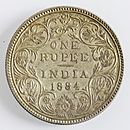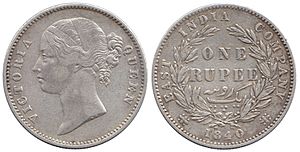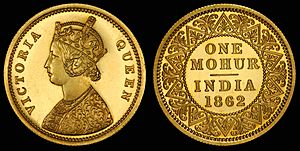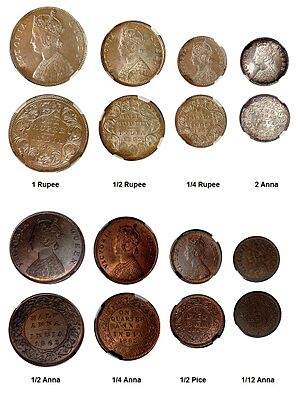Coins of British India facts for kids
| Indian rupee coin (1862) | |
|---|---|
 |
|
| Obverse: Crowned bust surrounded by inscription Victoria Queen | Reverse: Face value, country and date surrounded by wreath |
| Coin minted in 1862 and made of 91.7% silver | |
Coins made in India during British rule can be split into two main periods. First, there were coins issued by the East India Company (EIC) before 1835. Second, there were Imperial coins made directly by the British Crown after 1858.
The East India Company's coins had two phases. Initially, each of its three main areas – Madras Presidency, Bombay Presidency, and Bengal Presidency – had its own coins. Later, from 1835 to 1858, the EIC made a single type of coin for all British lands in India. After the Indian Rebellion of 1857, the British Crown took direct control. Coins from this time feature portraits of British rulers like Queen Victoria (1862–1901), Edward VII (1903–1910), George V (1911–1936), and George VI (1938–1947). No coins were made during the short reign of Edward VIII.
The East India Company first set up trading posts in India in the 1600s. These small posts grew into large colonies. Early settlements included Masulipatnam (1611), Madras (1640), Surat (1612), and Kolkata (1698–99). These became the Madras, Bombay, and Bengal Presidencies. Each Presidency had its own money system. Over time, the EIC created one unified coin system for all its Indian territories. After the 1857 rebellion, the British Crown took over. India became part of the British Empire. In 1877, Queen Victoria became "Empress of India." So, coin inscriptions changed from Victoria Queen to Victoria Empress. India became independent on August 15, 1947. The first coins of independent India were issued in 1950.
Contents
East India Company Coins
Queen Elizabeth I gave the English East India Company a special permission. This allowed them to have a trading monopoly with eastern countries like India. The East India Company divided its lands into three main areas. These were Madras in the south, Bombay in the west, and Bengal in the east. Much of northern India remained under Mughal or local rulers for a long time.
Each of these three presidencies made its own coins. This continued until 1835, when a single coin system was started. Early coins often looked like local Indian or Mughal coins. This helped people accept them more easily. The EIC even got permission to make coins in the name of the Mughal emperor Farrukhsiyar in Bombay in 1717.
Early Presidency Coins
In the west, major mints (places where coins are made) included Surat, Bombay, and Ahmadabad. The English sent their precious metals to these mints to be turned into gold mohurs and silver rupees. In 1672, the East India Company opened its own mint in Bombay. They made European-style gold, silver, copper, and tin coins. The gold coin was called Carolina, silver was Anglina, copper was Copperoon, and tin was Tinny.
In Bengal, the EIC gained the right to mint coins in 1757. After the Battle of Buxar in 1764, the Company gained control over large parts of eastern India. Early Bengal coins were made in the name of Mughal Emperors like Alamgir II and Shah Alam II.
The system for coin values became a standard in India. It used these ratios:
In 1793, the Bengal government ordered the making of sikka rupees. These were used as official money.
Imperial Coinage
After the Indian Rebellion of 1857–58, the British Crown took over India. From 1862 until India's independence in 1947, coins were made directly by the Crown. Early Imperial coins often had a fixed date, like 1862. This was done to stop the "batta" system. This was when money changers charged extra for older coins, even if they were in good condition.
Queen Victoria's Coins
Early gold coins with Queen Victoria's crowned face were one mohur coins dated 1862. These coins were used for trade. They were not official money. Many small differences exist in these coins. Mohurs with "Victoria Queen" were also made in 1875.
In 1876, Victoria became "Empress of India." From 1877, all coins said "Victoria Empress." Gold mohurs with this new title were made until 1891. Not many of these were made, so they are quite rare. Smaller gold coins, like ten and five rupees, were also made between 1870 and 1879.
Silver coins like the rupee, half rupee, quarter rupee, and two annas were also made. The 1862 rupee coins have many small design differences. These help identify where they were made. From 1863 to 1875, the Bombay mint used a system of dots to mark the coins. These dots were below the date or above the word "ONE." This practice stopped in 1874. This suggests the "batta" system was no longer a problem. Like other Victoria coins, the title changed to "Victoria Empress" in 1877. Rupee coins with Victoria's face were made until she died in 1901.
Edward VII Coins
| Indian rupee featuring bust of Edward VII | |
|---|---|
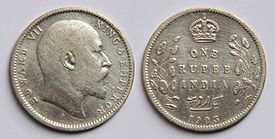 |
|
| Obverse: Profile of Edward VII surrounded by his name | Reverse: Face value, country and date. Spray of lotus flowers on each side and a crown above |
| Made of 91.7% silver. This particular coin was minted at Kolkata mint. | |
Coins with Edward VII's picture were made in many values. These included 1⁄12 anna, 1⁄2 pice, 1⁄4 anna, 1 anna, 2 annas, 1⁄4 rupee, 1⁄2 rupee, and 1 rupee. All these coins showed Edward VII without a crown. This was unusual. Usually, only coins for the United Kingdom itself showed the king without a crown. Coins for colonies usually showed him crowned. Only the 1 anna coin used a crowned picture.
George V Coins
| Indian rupee featuring bust of George V | |
|---|---|
 |
|
| Obverse: Profile of George V surrounded by his name | Reverse: Face value, country and date |
| Made of 91.7% silver | |
The picture of George V on these coins was a bit different from other British Empire coins. The King's robe had the Order of the Indian Empire instead of another order. This caused a problem with a 1911 One Rupee coin. It was called the Pig Rupee. It had to be redesigned. This was to make sure Muslims did not confuse the elephant on the King's collar for a pig.
Edward VIII Coins
During the very short time Edward VIII was king, no coins with his picture were made in India. Some Indian states, like Kutch, did make coins with his name in Indian script. You might see "Edward VIII" coins for sale online. But these are almost certainly new copies and were never officially made.
George VI Coins
Coins of many values were made during George VI's reign. These included fractions of an anna, pice, annas, and rupees. Larger gold coins like 5, 10, 15, and 30 rupees were also made. A British gold sovereign was also issued in 1918 as an emergency war coin.
Many rare coins from this time interest coin collectors. The 1939 rupee is very valuable. After 1939, all silver coins had less pure silver. This was because silver was scarce during World War II. The 1947 rupee, half rupee, quarter rupee, and anna coins are also special. This was the last year British coins were used in India.
See also
- History of Rupee
- Indian coinage
- Indian paisa
- Indian rupee
- Modern Indian coins



